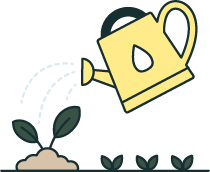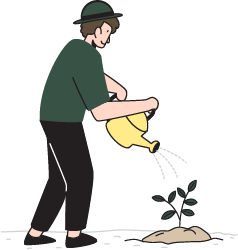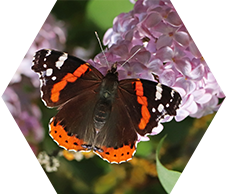

How to help pollinators?
The nature around us and the pollinators need our help. Let’s all take the necessary steps in our balconies and yards.
Set up a pollinator stop, create a pollinator trail
You can easily help the butterflies, bees, bumble bees and other pollinating bugs on your own balcony and in the courtyard of the apartment block. At the same time, you will promote more diverse nature and create a more pleasant environment for both pollinators and people.
Butterflies, bees and other pollinating insects travel from flower to flower. When we plant flowering oases on balconies and yards, we increase the living and mobility opportunities of useful pollinators. You can set up a pollinator stop i.e. a rest stop, a dining place and a pollinating area for pollinators by planting plants. The stop can be a small flower pot on a balcony or a larger area in the yard. The pollinator stops on different sides of the building and yard form a pollinator trail, along which important pollinators can pass from one stop to another in the yard, home block, residential area and the entire city.

Why do pollinators need stops and trails?
Habitats that are beneficial for polluting insects have decreased significantly, which has also led to a decrease in the number of pollinators. Flowering crops and wild plants as well as garden berries and fruits need pollinators to produce crops.
Every one of us can help pollinators, increase comfort and promote the diversity of nature. Challenge your neighbours, friends and relatives!
Plant flowers, set up an insect hotel, take other eco-actions that increase the diversity of nature.
Promote biodiversity in blocks of flats:
- Establish a planting that flowers all summer. It serves as an important rest, food and pollination stop for small pollinators.
- Minimize the use of processed plants in plantings. But start on a low threshold: pollinators like a variety of flowers, especially blue and yellow flowers!
- Grow herbs and vegetables in pots and boxes.
- Avoid using toxins and pesticides.
- Make an insect hotel, or buy one from a shop
- Is there a compost in your building? If not, suggest that one is acquired. Leaf and branch composts are also important nesting sites for many pollinators.

Turning the yard of a block of flats more organic
When improving the yard, it’s worth mimicing the layers of natural plants. When the plants in the yard are correctly selected, they require less treatment and cope better with pests and diseases.
Select hardy, domestic seedlings and plants that provide food for butterflies, bees and other pollinators. Ornamental plants that are not suitable for the yard biotype should be planted in pots.
If possible, at least part of the plot or its boundaries can be left as a natural area - garden species and natural plants are ideal for growing together. Various natural elements, such as moss-grown rocks and berry trees, should be left in the yard. The diversity of nature is also promoted by trees of different ages in the yard.
Increasing naturalness does not mean that the yard is not cared for. Plants are managed but moderately by fertilising and liming, and if necessary by cutting. It is a good idea to sweep some of the leaves under shrubs and to use leaves as a cover for sensitive herbaceous plants. For the summer, place nesting boxes for birds, bumblebees and bats - and remember to leave dried-up plants for feeding birds in the winter.
How diverse is your yard?
Can you find these in your yard?
- Insect hotel or a pile of branches
- Water dish for butterflies, other pollinators and birds
- Flowering shrubs and/or trees
- Decomposing leaves under shrubs
Which plants can be found in the yard and nearby areas? In the spring, use young leaves from, for example, dandelions, lady’s mantle, yarrow and sheep’s sorrel in salads, soups and stews.

Butterflies love, for example:
- Mezereon
- Garden rockcress
- Common lilac
- Sticky catchfly
- Sweet honeysuckle
- Field scabious
- Oregano
- Garden phlox (white)
- Blazing star
- Michaelmas daisy
- Ligularia x hessei
- Purple coneflower
- Alliums


How do I promote biodiversity in my neighbourhood?
- Familiarise yourself with the local nature - everyman's right allows you to move freely in forests and green areas.
- Find information about valuable nature sites near you and tell others about them.
- Do not damage plants and animals.
- Collect berries and mushrooms.
- Do not collect branches, lichens, moss and twigs without permission from the landowner.
- Keep dogs and cats on a leash.
- Do not leave rubbish in the wild.
Sources & further information (FI):
Pelasta pörriäinen (Maa- ja kotitalousnaiset)
Vihreä lippu (Ympäristökasvatusjärjestö FEE Suomi ry)
Kaupunkiluonto monimuotoiseksi (Helsingin kaupunki, Ympäristökeskus)


